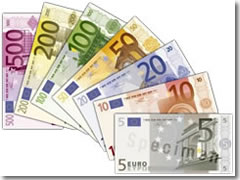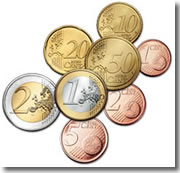- Places
- Plans
- Itineraries
- Experiences

Euro bills.Though credit cards have come into their own (and are, on the whole, cheaper to use than exchnaging dollars for cash euros), Italy is still primarily a cash economy—and the cash in question is the euro.
Money talks, and in Italy euros, speak the local lingo a lot better than do dollars, credit cards, or traveler's checks.
Italy, like most of Western Europe, now uses the Euro. Italians pronounce every vowel in that word, which is a bit hard on American tongues, but sounds something like "ay-YOU-rrr-oh" (and don't forget to roll that "r).
Euros come in various shapes and sizes:
(For the record, Italy's old currency was called the lira, plural: lire and, yes, you could buy 1,500 of them with a single U.S. dollar—though that is misleading, since the buying power of 1,500L was about the same as $1, so the extra zeros were superfluous.)

It currently takes between $1.40 and $1.50 to buy €1. Ouch. Here's more on changing money.
First of all, transactions in local currency are quicker, and they will certainly endear you to the merchant you're dealing with, since he knows he won’t have to kick a big chunk of his profits back to the folks at Visa or American Express.
Don't think that doesn't count for something. Though cash vs. credit prices at U.S. gas pumps may be a relic of the past, you can bet your last Euro-cent that you will often find a surprise discount if you pay in cash (like 5%) on such big ticket items as hotel rooms.
In fact, whenever you're discussing price on something, always ask, "Is that how much if I pay cash...?" You'll be surprised how often the number comes down a bit, especially for longer stays or larger purchases. (Note: don't try this for a single orange from the fruit vendor, or the three-pack of undies at a department store.)
Heck, sometimes even the waiter at dinner will come to your table at the end of the meal, tot up the bill in his head, and then ask "cash or Visa?" The correct answer to that is always "Cash" because it means you get a discount.
Why is this? Well, like I said, they don't have to factor into the final price that kickback to the credit card company. Plus—though you didn't hear it from me and of course I’d in no way encourage European merchants to break the law or imply that any do so—when you pay cash, they are free to enter any old amount they want on the ledger books.
Though you didn't hear that from me.
So how do you get your Euro on? If possible, always get cash from an ATM
—though you can also cash traveler's checks and get credit card cash advances, both end up costing more.
Some folks also buy some euros from their bank before leaving home. I used to try this tactic, but found that there's almost always an ATM or two at any airport or train station when I arrive and have found it to be unnecessary.
(Caveat: on my last trip to Ireland—in 2003—all of the bank machines at Shannon's arrivals terminal were out of order; since I was picking up a pre-paid car rental, I just drove along until I spotted a bank.)
The reason I stopped getting starter cash in local currencies is that (a) you get a truly crappy exchange rate, paying way to much on the dollar plus a sizeable bank fee just to get $30 worth of European currency, and (b) with the introduction of the Euro, I usually have some cash left over from last trip anyway. I realize that "(b)" only works for frequent travelers, but there you go.
If you do decide to carry along some primer cash, know that you can usually get it only from major, downtown banks, though your local branch might be able to order it from a larger branch (give them plenty of notice).
It doesn’t have to be your regular bank, either. Any old financial institution will sell you Euros, British Pounds, or Swiss Francs (Eastern European currencies are harder to come by), though some will waive certain fees only for their own customers.
Share this page
Search ReidsItaly.com